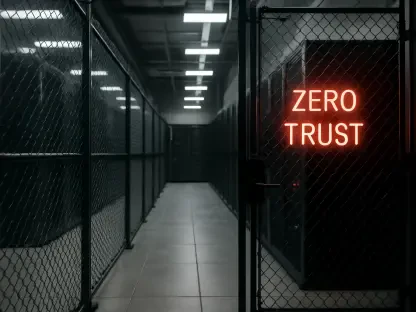Artificial Intelligence (AI) has undeniably revolutionized numerous industries, enhancing efficiencies and transforming work environments. However, this technological advancement has also introduced complex cybersecurity challenges that organizations must navigate. As AI ingrains itself deeper into the fabric of business operations, the potential for malicious exploitation grows. Consequently, organizations are increasingly leaning toward the Zero Trust security model to effectively counteract these emerging threats.
The Evolution of Cybersecurity Needs
Shift from Perimeter-Based Security
Traditional security frameworks, heavily reliant on perimeter-based defenses like firewalls, often fall short in today’s dynamic digital workspace. As technological progress drives organizations to adopt more cloud-centric and remote models, traditional methods struggle to ensure adequate protection. This shift challenges the old paradigm, which depended on a defined boundary that no longer exists in modern setups. Instead of securing boundaries, there is a growing need for a security approach that protects each user, device, and transaction independently. The Zero Trust model fits this requirement by treating every network transaction as suspect, ensuring robust security across dispersed digital landscapes. This model offers organizations an opportunity to deal with fluid work patterns without compromising security. With businesses adopting cloud services and remote working policies, the move away from central gateways to decentralized access points is becoming more common.
Zscaler’s Innovative Approach
Zscaler’s Zero Trust Exchange platform, operational for nearly two decades, stands out as a key innovation addressing cybersecurity needs in an AI-driven era. By prioritizing data privacy and sovereignty, this platform builds trust among users by ensuring log files are stored within specific user regions. This is especially significant in Europe, where stringent data standards have driven demand for localized data storage solutions. Zscaler’s ability to adapt to hybrid work environments further solidifies its relevance. As it facilitates secure interactions among distributed users, applications, and data, the platform provides a protective layer that can withstand the challenges posed by contemporary digital topographies. Consequently, it empowers organizations to confidently manage their AI-enhanced operations without compromising security or compliance.
AI’s Dual Role in Security
Advantages of Predictive AI
AI’s role in cybersecurity is multifaceted; while it offers advanced tools to enhance protection, it can also introduce vulnerabilities. Zscaler leverages predictive AI to fortify its defenses, highlighting the transformative advantages AI can bring to threat detection. Through advanced sandboxing technologies, the platform effectively identifies and neutralizes zero-day attacks, providing a proactive stance against cyber threats. Such AI-driven capabilities showcase how the technology can serve as a formidable ally in maintaining robust security. By identifying potential threats at nascent stages, organizations can significantly reduce the risk of breaches, safeguarding both operations and sensitive data. The continuous evolvement of AI-based tools ensures that defenses remain adaptive in the face of ever-evolving cyber threats.
Risks of Autonomous AI
However, AI’s potential downside emerges in the form of autonomous AI agents capable of executing tasks independently. The risk of these agents being manipulated by malicious actors poses a real threat to organizational security. Hackers can potentially exploit AI’s autonomous nature to bypass standard security protocols, resulting in significant data breaches or operational disruptions. To counter these risks, a structured approach that limits AI actions to predefined rights is essential. The Zero Trust security model provides this oversight, allowing organizations to harness AI’s capabilities safely within existing frameworks. As businesses continue to integrate AI into core processes, deploying Zero Trust principles becomes even more critical in mitigating potential security breaches.
Industry Shift Towards Zero Trust
Changing Attitudes of CISOs
The evolving landscape of cybersecurity has shifted industry perceptions and security strategies. A decade ago, cloud-based security models, including Zero Trust, were met with skepticism. Many Chief Information Security Officers (CISOs) hesitated to embrace these new approaches, in part due to concerns about relying on cloud infrastructures for critical security functions. However, this has changed drastically as more organizations witness the advantages of adopting Zero Trust. As cloud technologies become mainstream, even traditional firewall vendors have started aligning their offerings with Zero Trust principles. This shift indicates a broader acceptance of cloud-based security innovations and a departure from legacy frameworks. Industry trends suggest that as cybersecurity threats evolve, so too will the opportunities for more advanced models to become entrenched.
Implementing Zero Trust with AI
Artificial Intelligence (AI) has dramatically transformed various sectors by boosting productivity and altering how workplaces function. Despite these benefits, this rapid technological progress has led to significant cybersecurity challenges that businesses must grapple with. As AI becomes increasingly integral to business operations, the risk of its misuse by bad actors also rises, creating new vulnerabilities. In response to these challenges, many organizations are adopting the Zero Trust security model. This model operates on the principle of “trust but verify,” aiming to protect sensitive data by requiring validation at every stage of digital interactions, thereby minimizing the chances of a breach. By implementing stringent identity verification measures and continuous monitoring, businesses aim to create a secure network environment resilient to potential threats. Moving forward, the integration of AI with advanced security measures is essential for protecting digital infrastructures. Such strategic adaptations are crucial to navigating the evolving landscape of cybersecurity effectively.









